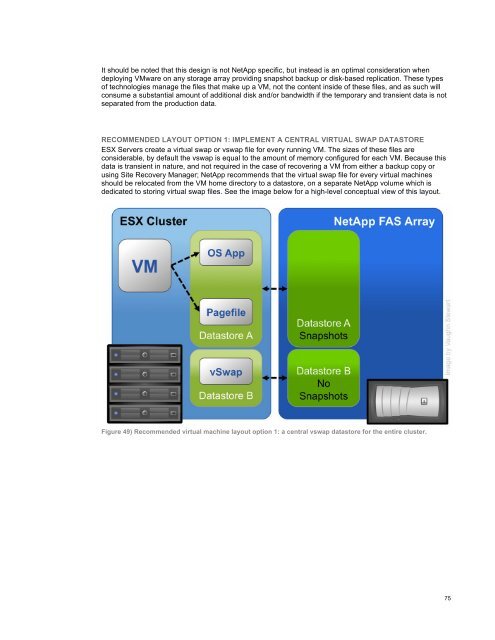NetApp and VMware vSphere Storage Best Practices
NetApp and VMware vSphere Storage Best Practices
NetApp and VMware vSphere Storage Best Practices
Create successful ePaper yourself
Turn your PDF publications into a flip-book with our unique Google optimized e-Paper software.
It should be noted that this design is not <strong>NetApp</strong> specific, but instead is an optimal consideration when<br />
deploying <strong>VMware</strong> on any storage array providing snapshot backup or disk-based replication. These types<br />
of technologies manage the files that make up a VM, not the content inside of these files, <strong>and</strong> as such will<br />
consume a substantial amount of additional disk <strong>and</strong>/or b<strong>and</strong>width if the temporary <strong>and</strong> transient data is not<br />
separated from the production data.<br />
RECOMMENDED LAYOUT OPTION 1: IMPLEMENT A CENTRAL VIRTUAL SWAP DATASTORE<br />
ESX Servers create a virtual swap or vswap file for every running VM. The sizes of these files are<br />
considerable, by default the vswap is equal to the amount of memory configured for each VM. Because this<br />
data is transient in nature, <strong>and</strong> not required in the case of recovering a VM from either a backup copy or<br />
using Site Recovery Manager; <strong>NetApp</strong> recommends that the virtual swap file for every virtual machines<br />
should be relocated from the VM home directory to a datastore, on a separate <strong>NetApp</strong> volume which is<br />
dedicated to storing virtual swap files. See the image below for a high-level conceptual view of this layout.<br />
Figure 49) Recommended virtual machine layout option 1: a central vswap datastore for the entire cluster.<br />
75


